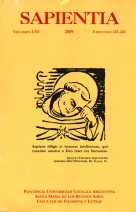Please use this identifier to cite or link to this item:
https://repositorio.uca.edu.ar/handle/123456789/3604| Título: | Turning Sen's capability approach operative thanks to Aristotle's ideas | Autor: | Crespo, Ricardo F. | Palabras clave: | Aristóteles, 384-322 a. C.; Sen, Amartya; DESIGUALDAD SOCIAL; LIBERTAD; FILOSOFIA POLITICA; FILOSOFIA ECONOMICA | Fecha de publicación: | 2009 | Editorial: | Pontificia Universidad Católica Argentina. Facultad de Filosofía y Letras | Cita: | Crespo, R. Turning Sen's capability approach operative thanks to Aristotle's ideas [en línea]. Sapientia. 2009, 65 (225-226). Disponible en: https://repositorio.uca.edu.ar/handle/123456789/3604 | Resumen: | Resumen: The capabilities approaches (CA) have been originated in the work of the economist Amartya Sen on inequality. Sen, born in India in 1933, is currently Emeritus Professor of Harvard University. He is still active in teaching and researching. He was always concerned with the problem of social justice, poverty and equality. This has led him to hold a broad notion and an ethical view of economics. Driven by these concerns, Sen tackled the topics of inequality and quality of life, and during the 80s he formulated the capability approach. Sen’s capability approach is a broad normative framework for the evaluation and assessment of individual well-being, development of countries, present socio-economic situation and social arrangements in order to implement right policies. For Sen, human agency is a crucial element of human well-being in a broad sense that goes beyond utility and that is related to the quality of life. Human agency entails freedom: Freedoms are capabilities of performing some actions, called by him “functionings”. These capabilities and functionings compose a good life. Capabilities, for Sen, are a better way of assessing well-being than utility or income (for a good survey, see e.g., Sen 1993 and Ingrid Robeyns 2005). Nobody would deny that this is good news. A concern among scholars, however, has arisen about the operationality of Sen’s CA. Traits as the incommensurability of capabilities and their ambiguous definition (see Sen 1999: 76- 7) are sufficient reasons for this concern. As Robert Sugden affirms, “it is natural to ask how far Sen’s framework is operational” (1993: 1953). Some arguments for this lack of operationality might be summarized in terms of the inexact or “vague” character of practical reason, the capacity that lies behind the whole CA (on the central role of practical reason within the CA see Nussbaum 1987: 47 and 1995a). For Sen, indeed, the capabilities’s ambiguity, both in their definition and in their election, is a positive feature because it reflects and respects the freedom and the differences of the persons (1993: 33-34): for him, asserting ambiguity and fuzziness is not a weakness but a strength. | URI: | https://repositorio.uca.edu.ar/handle/123456789/3604 | ISSN: | 0036-4703 | Disciplina: | FILOSOFIA | Derechos: | Acceso Abierto | Fuente: | Versión original impresa en Sistema de Bibliotecas UCA: Sapientia Vol. LXV, Nº 225-226, 2009 |
| Appears in Collections: | SAP - 2009 Vol LXV nro. 225-226 |
Files in This Item:
| File | Description | Size | Format | |
|---|---|---|---|---|
| turning-sen-capability-approach-operative.pdf | 174,5 kB | Adobe PDF |  View/Open |
Page view(s)
106
checked on Apr 27, 2024
Download(s)
78
checked on Apr 27, 2024
Google ScholarTM
Check
This item is licensed under a Creative Commons License

